Editing the Melanocortin-4 Receptor Gene in Channel Catfish Using the CRISPR-Cas9 System
Abstract
1. Introduction
2. Materials and Methods
2.1. Experiment I: Electroporation
2.1.1. Design of the CRISPR-Cas9 System
2.1.2. Preparation of Plasmids for Electroporation
2.1.3. Channel Catfish Spawning
2.1.4. Fertilization, Electroporation, and Embryo Incubation
2.2. Experiment II: Microinjection
2.2.1. Design and Preparation of sgRNA and CRISPR/Cas9 System
2.2.2. Fertilization and Microinjection
2.3. Mutation Analysis
2.3.1. Genomic DNA Extraction
2.3.2. Polymerase Chain Reaction (PCR) and Surveyor Mutation Detection Assay
2.3.3. Cloning and Sequencing
2.3.4. Detection of Plasmid Integration
2.4. Evaluation of Growth and Feed Efficiency
2.5. Statistical Analysis
3. Results
3.1. Experiment I: Electroporation
3.1.1. Embryo Mortality, Hatchability, and Fry Survival
3.1.2. Identification of Mutations, Mosaicism, and Plasmid Integration
3.1.3. Evaluation of Growth and Feed Efficiency in Experiment I
3.2. Experiment II: Microinjection
3.2.1. Embryo Mortality, Hatchability, and Fry Survival
3.2.2. Identification of Mutations and Mosaicism
3.2.3. Evaluation of Growth of Microinjected Fry in Experiment II (Microinjection)
4. Discussion
5. Conclusions
Author Contributions
Funding
Institutional Review Board Statement
Data Availability Statement
Acknowledgments
Conflicts of Interest
References
- Li, Y.; Wang, X.; Lu, L.; Wang, M.; Zhai, Y.; Tai, X.; Dilimulati, D.; Lei, X.; Xu, J.; Zhang, C. Identification of novel GPCR partners of the central melanocortin signaling. Mol. Metab. 2021, 53, 101317. [Google Scholar] [CrossRef] [PubMed]
- Ji, L.-Q.; Hong, Y.; Tao, Y.-X. Melanocortin-5 receptor: Pharmacology and its regulation of energy metabolism. Int. J. Mol. Sci. 2022, 23, 8727. [Google Scholar] [CrossRef] [PubMed]
- Logan, D.W.; Bryson-Richardson, R.J.; Taylor, M.S.; Currie, P.; Jackson, I.J. Sequence characterization of teleost fish melanocortin receptors. Ann. N. Y. Acad. Sci. 2003, 994, 319–330. [Google Scholar] [CrossRef] [PubMed]
- Logan, D.W.; Bryson-Richardson, R.J.; Pagán, K.E.; Taylor, M.S.; Currie, P.D.; Jackson, I.J. The structure and evolution of the melanocortin and MCH receptors in fish and mammals. Genomics 2003, 81, 184–191. [Google Scholar] [CrossRef] [PubMed]
- Ringholm, A.; Fredriksson, R.; Poliakova, N.; Yan, Y.L.; Postlethwait, J.H.; Larhammar, D.; Schiöth, H.B. One melanocortin 4 and two melanocortin 5 receptors from zebrafish show remarkable conservation in structure and pharmacology. J. Neurochem. 2002, 82, 6–18. [Google Scholar] [CrossRef]
- Gantz, I.; Miwa, H.; Konda, Y.; Shimoto, Y.; Tashiro, T.; Watson, S.; DelValle, J.; Yamada, T. Molecular cloning, expression, and gene localization of a fourth melanocortin receptor. J. Biol. Chem. 1993, 268, 15174–15179. [Google Scholar] [CrossRef]
- Mountjoy, K.G.; Mortrud, M.T.; Low, M.J.; Simerly, R.B.; Cone, R.D. Localization of the melanocortin-4 receptor (MC4-R) in neuroendocrine and autonomic control circuits in the brain. Mol. Endocrinol. 1994, 8, 1298–1308. [Google Scholar] [CrossRef]
- Schjolden, J.; Schiöth, H.B.; Larhammar, D.; Winberg, S.; Larson, E.T. Melanocortin peptides affect the motivation to feed in rainbow trout (Oncorhynchus mykiss). Gen. Comp. Endocrinol. 2009, 160, 134–138. [Google Scholar] [CrossRef]
- Kobayashi, Y.; Tsuchiya, K.; Yamanome, T.; Schiöth, H.B.; Kawauchi, H.; Takahashi, A. Food deprivation increases the expression of melanocortin-4 receptor in the liver of barfin flounder, Verasper moseri. Gen. Comp. Endocrinol. 2008, 155, 280–287. [Google Scholar] [CrossRef]
- Song, Y.; Cone, R.D. Creation of a genetic model of obesity in a teleost. FASEB J. 2007, 21, 2042–2049. [Google Scholar] [CrossRef]
- Huszar, D.; Lynch, C.A.; Fairchild-Huntress, V.; Dunmore, J.H.; Fang, Q.; Berkemeier, L.R.; Gu, W.; Kesterson, R.A.; Boston, B.A.; Cone, R.D. Targeted disruption of the melanocortin-4 receptor results in obesity in mice. Cell 1997, 88, 131–141. [Google Scholar] [CrossRef] [PubMed]
- Cerdá-Reverter, J.M.; Ling, M.K.; Schiöth, H.B.; Peter, R.E. Molecular cloning, characterization and brain mapping of the melanocortin 5 receptor in the goldfish. J. Neurochem. 2003, 87, 1354–1367. [Google Scholar] [CrossRef] [PubMed]
- Ringholm, A.; Klovins, J.; Fredriksson, R.; Poliakova, N.; Larson, E.T.; Kukkonen, J.P.; Larhammar, D.; Schiöth, H.B. Presence of melanocortin (MC4) receptor in spiny dogfish suggests an ancient vertebrate origin of central melanocortin system. Eur. J. Biochem. 2003, 270, 213–221. [Google Scholar] [CrossRef]
- Sánchez, E.; Rubio, V.C.; Thompson, D.; Metz, J.; Flik, G.; Millhauser, G.L.; Cerdá-Reverter, J.M. Phosphodiesterase inhibitor-dependent inverse agonism of agouti-related protein on melanocortin 4 receptor in sea bass (Dicentrarchus labrax). Am. J. Physiol. Regul. Integr. Comp. Physiol. 2009, 296, R1293–R1306. [Google Scholar] [CrossRef] [PubMed]
- Wan, Y.; Zhang, Y.; Ji, P.; Li, Y.; Xu, P.; Sun, X. Molecular characterization of CART, AgRP, and MC4R genes and their expression with fasting and re-feeding in common carp (Cyprinus carpio). Mol. Biol. Rep. 2012, 39, 2215–2223. [Google Scholar] [CrossRef]
- Li, L.; Yang, Z.; Zhang, Y.-P.; He, S.; Liang, X.-F.; Tao, Y.-X. Molecular cloning, tissue distribution, and pharmacological characterization of melanocortin-4 receptor in grass carp (Ctenopharyngodon idella). Domest. Anim. Endocrinol. 2017, 59, 140–151. [Google Scholar] [CrossRef]
- Zhou, Y.; Li, Y.; Lei, L.; Deng, X.; Duan, Y.; Fu, S.; Zhang, J.; Yuan, D.; Zhou, C.; He, W. The melanocortin-4 receptor (MC4R) gene in the gibel carp Carassius auratus gibelio: Cloning, tissue distribution, and fasting effects. Aquac. Int. 2022, 30, 2425–2438. [Google Scholar] [CrossRef]
- Wen, Z.-Y.; Liu, T.; Qin, C.-J.; Zou, Y.-C.; Wang, J.; Li, R.; Tao, Y.-X. MRAP2 interaction with melanocortin-4 receptor in snakehead (Channa argus). Biomolecules 2021, 11, 481. [Google Scholar] [CrossRef]
- Zhang, K.-Q.; Hou, Z.-S.; Wen, H.-S.; Li, Y.; Qi, X.; Li, W.-J.; Tao, Y.-X. Melanocortin-4 receptor in spotted sea bass, Lateolabrax maculatus: Cloning, tissue distribution, physiology, and pharmacology. Front. Endocrinol. 2019, 10, 705. [Google Scholar] [CrossRef]
- Haitina, T.; Klovins, J.; Andersson, J.; Fredriksson, R.; Lagerström, M.C.; Larhammar, D.; Larson, E.T.; Schiöth, H.B. Cloning, tissue distribution, pharmacology and three-dimensional modelling of melanocortin receptors 4 and 5 in rainbow trout suggest close evolutionary relationship of these subtypes. Biochem. J. 2004, 380, 475–486. [Google Scholar] [CrossRef]
- Stäubert, C.; Tarnow, P.; Brumm, H.; Pitra, C.; Gudermann, T.; Gruters, A.; Schöneberg, T.; Biebermann, H.; Römpler, H. Evolutionary aspects in evaluating mutations in the melanocortin 4 receptor. Endocrinology 2007, 148, 4642–4648. [Google Scholar] [CrossRef] [PubMed]
- Liu, R.; Kinoshita, M.; Adolfi, M.C.; Schartl, M. Analysis of the role of the Mc4r system in development, growth, and puberty of medaka. Front. Endocrinol. 2019, 10, 213. [Google Scholar] [CrossRef] [PubMed]
- Yang, Y.; Li, Q.; Shu, H.; Zhou, H.; Li, X.; Hou, L. Characterization of the melanocortin-4 receptor gene from Spinibarbus hollandi and the association between its polymorphisms and S. hollandi growth traits. Fish. Sci. 2017, 83, 967–976. [Google Scholar] [CrossRef]
- Loos, R.J.; Lindgren, C.M.; Li, S.; Wheeler, E.; Zhao, J.H.; Prokopenko, I.; Inouye, M.; Freathy, R.M.; Attwood, A.P.; Beckmann, J.S. Common variants near MC4R are associated with fat mass, weight and risk of obesity. Nat. Genet. 2008, 40, 768–775. [Google Scholar] [CrossRef]
- Yeo, G.S.; Farooqi, I.S.; Aminian, S.; Halsall, D.J.; Stanhope, R.G.; O’Rahilly, S. A frameshift mutation in MC4R associated with dominantly inherited human obesity. Nat. Genet. 1998, 20, 111–112. [Google Scholar] [CrossRef] [PubMed]
- Butler, A.A.; Marks, D.L.; Fan, W.; Kuhn, C.M.; Bartolome, M.; Cone, R.D. Melanocortin-4 receptor is required for acute homeostatic responses to increased dietary fat. Nat. Neurosci. 2001, 4, 605–611. [Google Scholar] [CrossRef]
- Chen, A.S.; Metzger, J.M.; Trumbauer, M.E.; Guan, X.-M.; Yu, H.; Frazier, E.G.; Marsh, D.J.; Forrest, M.J.; Gopal-Truter, S.; Fisher, J. Role of the melanocortin-4 receptor in metabolic rate and food intake in mice. Transgenic Res. 2000, 9, 145–154. [Google Scholar] [CrossRef]
- Garza, J.C.; Kim, C.S.; Liu, J.; Zhang, W.; Lu, X.-Y. Adeno-associated virus-mediated knockdown of melanocortin-4 receptor in the paraventricular nucleus of the hypothalamus promotes high-fat diet-induced hyperphagia and obesity. J. Endocrinol. 2008, 197, 471–482. [Google Scholar] [CrossRef]
- Marie, L.S.; Miura, G.I.; Marsh, D.J.; Yagaloff, K.; Palmiter, R.D. A metabolic defect promotes obesity in mice lacking melanocortin-4 receptors. Proc. Natl. Acad. Sci. USA 2000, 97, 12339–12344. [Google Scholar] [CrossRef]
- Sutton, G.M.; Trevaskis, J.L.; Hulver, M.W.; McMillan, R.P.; Markward, N.J.; Babin, M.J.; Meyer, E.A.; Butler, A.A. Diet-genotype interactions in the development of the obese, insulin-resistant phenotype of C57BL/6J mice lacking melanocortin-3 or-4 receptors. Endocrinology 2006, 147, 2183–2196. [Google Scholar] [CrossRef]
- Weide, K.; Christ, N.; Moar, K.M.; Arens, J.; Hinney, A.; Mercer, J.G.; Eiden, S.; Schmidt, I. Hyperphagia, not hypometabolism, causes early onset obesity in melanocortin-4 receptor knockout mice. Physiol. Genom. 2003, 13, 47–56. [Google Scholar] [CrossRef] [PubMed]
- Coogan, M.; Alston, V.; Su, B.; Khalil, K.; Elaswad, A.; Khan, M.; Johnson, A.; Xing, D.; Li, S.; Wang, J. Improved growth and high inheritance of melanocortin-4 receptor (mc4r) mutation in CRISPR/Cas-9 gene-edited channel catfish, Ictalurus punctatus. Mar. Biotechnol. 2022, 24, 843–855. [Google Scholar] [CrossRef] [PubMed]
- Doudna, J.A.; Charpentier, E. The new frontier of genome engineering with CRISPR-Cas9. Science 2014, 346, 1258096. [Google Scholar] [CrossRef]
- Elaswad, A.; Khalil, K.; Cline, D.; Page-McCaw, P.; Chen, W.; Michel, M.; Cone, R.; Dunham, R. Microinjection of CRISPR/Cas9 protein into channel catfish, Ictalurus punctatus, embryos for gene editing. J. Vis. Exp. 2018, 131, e56275. [Google Scholar] [CrossRef]
- Chakrapani, V.; Patra, S.K.; Panda, R.P.; Rasal, K.D.; Jayasankar, P.; Barman, H.K. Establishing targeted carp TLR22 gene disruption via homologous recombination using CRISPR/Cas9. Dev. Comp. Immunol. 2016, 61, 242–247. [Google Scholar] [CrossRef]
- Edvardsen, R.B.; Leininger, S.; Kleppe, L.; Skaftnesmo, K.O.; Wargelius, A. Targeted mutagenesis in Atlantic salmon (Salmo salar L.) using the CRISPR/Cas9 system induces complete knockout individuals in the F0 generation. PLoS ONE 2014, 9, e108622. [Google Scholar] [CrossRef]
- Li, M.; Yang, H.; Zhao, J.; Fang, L.; Shi, H.; Li, M.; Sun, Y.; Zhang, X.; Jiang, D.; Zhou, L. Efficient and heritable gene targeting in tilapia by CRISPR/Cas9. Genetics 2014, 197, 591–599. [Google Scholar] [CrossRef]
- Zhong, Z.; Niu, P.; Wang, M.; Huang, G.; Xu, S.; Sun, Y.; Xu, X.; Hou, Y.; Sun, X.; Yan, Y. Targeted disruption of sp7 and myostatin with CRISPR-Cas9 results in severe bone defects and more muscular cells in common carp. Sci. Rep. 2016, 6, 22953. [Google Scholar] [CrossRef]
- Coogan, M.; Alston, V.; Su, B.; Khalil, K.; Elaswad, A.; Khan, M.; Simora, R.M.; Johnson, A.; Xing, D.; Li, S. CRISPR/Cas-9 induced knockout of myostatin gene improves growth and disease resistance in channel catfish (Ictalurus punctatus). Aquaculture 2022, 557, 738290. [Google Scholar] [CrossRef]
- USDA National Agricultural Statistics Service. Catfish Production. Available online: https://www.nass.usda.gov/Publications/Todays_Reports/reports/cfpd0221.pdf (accessed on 5 February 2023).
- Dunham, R.A.; Elaswad, A. Catfish biology and farming. Annu. Rev. Anim. Biosci. 2018, 6, 305–325. [Google Scholar] [CrossRef]
- Yin, L.; Maddison, L.A.; Li, M.; Kara, N.; LaFave, M.C.; Varshney, G.K.; Burgess, S.M.; Patton, J.G.; Chen, W. Multiplex conditional mutagenesis using transgenic expression of Cas9 and sgRNAs. Genetics 2015, 200, 431–441. [Google Scholar] [CrossRef] [PubMed]
- Jao, L.-E.; Wente, S.R.; Chen, W. Efficient multiplex biallelic zebrafish genome editing using a CRISPR nuclease system. Proc. Natl. Acad. Sci. USA 2013, 110, 13904–13909. [Google Scholar] [CrossRef] [PubMed]
- Dunham, R.A.; Elaswad, A.; Qin, Z. Gene Editing in Channel Catfish via Double Electroporation of Zinc-Finger Nucleases. In Zinc Finger Proteins: Methods and Protocols; Liu, J., Ed.; Springer: New York, NY, USA, 2018; pp. 201–214. [Google Scholar]
- Kang, J.-H.; Yoshizaki, G.; Homma, O.; Strüssmann, C.A.; Takashima, F. Effect of an osmotic differential on the efficiency of gene transfer by electroporation of fish spermatozoa. Aquaculture 1999, 173, 297–307. [Google Scholar] [CrossRef]
- Dunham, R.A.; Winn, R.N. Production of Transgenic Fish. In Transgenic Animal Technology: A Laboratory Handbook; Elsevier BV: Amsterdam, The Netherlands, 2014; pp. 308–336. [Google Scholar]
- Powers, D.A.; Hereford, L.; Cole, T.; Chen, T.T.; Lin, C.; Kight, K.; Creech, K.; Dunham, R. Electroporation: A method for transferring genes into the gametes of zebrafish (Brachydanio rerio), channel catfish (Ictalurus punctatus), and common carp (Cyprinus carpio). Mol. Mar. Biol. Biotechnol. 1991, 1, 301–308. [Google Scholar]
- Bart, A.; Dunham, R. Effects of sperm concentration and egg number on fertilization efficiency with channel catfish (Ictalurus punctatus) eggs and blue catfish (I. furcatus) spermatozoa. Theriogenology 1996, 45, 673–682. [Google Scholar] [CrossRef]
- Armstrong, J.; Duhon, S.; Malacinski, G. Raising the Axolotl in Captivity. In Developmental Biology of The Axolotl; Oxford University Press: New York, NY, USA, 1989; pp. 220–227. [Google Scholar]
- Moreno-Mateos, M.A.; Vejnar, C.E.; Beaudoin, J.-D.; Fernandez, J.P.; Mis, E.K.; Khokha, M.K.; Giraldez, A.J. CRISPRscan: Designing highly efficient sgRNAs for CRISPR-Cas9 targeting in vivo. Nat. Methods 2015, 12, 982–988. [Google Scholar] [CrossRef] [PubMed]
- Varshney, G.K.; Pei, W.; LaFave, M.C.; Idol, J.; Xu, L.; Gallardo, V.; Carrington, B.; Bishop, K.; Jones, M.; Li, M. High-throughput gene targeting and phenotyping in zebrafish using CRISPR/Cas9. Genome Res. 2015, 25, 1030–1042. [Google Scholar] [CrossRef] [PubMed]
- Tucker, C.C.; Robinson, E.H. Channel Catfish Farming Handbook; Springer Science & Business Media: Berlin/Heidelberg, Germany, 1990. [Google Scholar]
- Elaswad, A.; Khalil, K.; Ye, Z.; Liu, Z.; Liu, S.; Peatman, E.; Odin, R.; Vo, K.; Drescher, D.; Gosh, K. Effects of CRISPR/Cas9 dosage on TICAM1 and RBL gene mutation rate, embryonic development, hatchability and fry survival in channel catfish. Sci. Rep. 2018, 8, 16499. [Google Scholar] [CrossRef]
- Elaswad, A.; Khalil, K.; Ye, Z.; Alsaqufi, A.; Abdelrahman, H.; Su, B.; Perera, D.A.; Dong, S.; Abass, N.; Dunham, R. Effects of cecropin transgenesis and interspecific hybridization on the resistance to Ichthyophthirius multifiliis in channel catfish and female channel catfish × male blue catfish hybrids. N. Am. J. Aquac. 2019, 81, 242–252. [Google Scholar] [CrossRef]
- Gerard, G.; Shandilya, H.; Qiu, P.; Shi, Y.; Lo, J. Genetic Variance Detection Using Surveyor Nuclease. In Genetic Variance Detection-Technologies for Pharmacogenomics; Hecker, K.H., Ed.; DNA Press: Eagleville, PA, USA, 2006; pp. 95–129. [Google Scholar]
- Qiu, P.; Shandilya, H.; D’Alessio, J.M.; O’Connor, K.; Durocher, J.; Gerard, G.F. Mutation detection using Surveyor™ nuclease. Biotechniques 2004, 36, 702–707. [Google Scholar] [CrossRef]
- Gratz, S.J.; Cummings, A.M.; Nguyen, J.N.; Hamm, D.C.; Donohue, L.K.; Harrison, M.M.; Wildonger, J.; O’Connor-Giles, K.M. Genome engineering of Drosophila with the CRISPR RNA-guided Cas9 nuclease. Genetics 2013, 194, 1029–1035. [Google Scholar] [CrossRef]
- Ansai, S.; Kinoshita, M. Targeted mutagenesis using CRISPR/Cas system in medaka. Biol. Open 2014, 3, 362–371. [Google Scholar] [CrossRef] [PubMed]
- Shen, B.; Zhang, J.; Wu, H.; Wang, J.; Ma, K.; Li, Z.; Zhang, X.; Zhang, P.; Huang, X. Generation of gene-modified mice via Cas9/RNA-mediated gene targeting. Cell Res. 2013, 23, 720. [Google Scholar] [CrossRef] [PubMed]
- Hongbing, H.; Yonghe, M.; Tao, W.; Ling, L.; Xiuzhi, T.; Rui, H.; Shoulong, D.; Kongpan, L.; Feng, W.; Ning, L. One-step generation of myostatin gene knockout sheep via the CRISPR/Cas9 system. Front. Agric. Sci. Eng. 2014, 1, 2–5. [Google Scholar] [CrossRef]
- Ikeda, M.; Matsuyama, S.; Akagi, S.; Ohkoshi, K.; Nakamura, S.; Minabe, S.; Kimura, K.; Hosoe, M. Correction of a disease mutation using CRISPR/Cas9-assisted genome editing in Japanese black cattle. Sci. Rep. 2017, 7, 17827. [Google Scholar] [CrossRef]
- Cong, L.; Ran, F.A.; Cox, D.; Lin, S.; Barretto, R.; Habib, N.; Hsu, P.D.; Wu, X.; Jiang, W.; Marraffini, L.A. Multiplex genome engineering using CRISPR/Cas systems. Science 2013, 339, 819–823. [Google Scholar] [CrossRef] [PubMed]
- Mali, P.; Yang, L.; Esvelt, K.M.; Aach, J.; Guell, M.; DiCarlo, J.E.; Norville, J.E.; Church, G.M. RNA-guided human genome engineering via Cas9. Science 2013, 339, 823–826. [Google Scholar] [CrossRef]
- Qin, G.; Qin, Z.; Lu, C.; Ye, Z.; Elaswad, A.; Bangs, M.; Li, H.; Zhang, Y.; Huang, Y.; Shi, H. Gene editing of the catfish gonadotropin-releasing hormone gene and hormone therapy to control the reproduction in channel catfish, Ictalurus punctatus. Biology 2022, 11, 649. [Google Scholar] [CrossRef]
- Khalil, K.; Elayat, M.; Khalifa, E.; Daghash, S.; Elaswad, A.; Miller, M.; Abdelrahman, H.; Ye, Z.; Odin, R.; Drescher, D. Generation of myostatin gene-edited channel catfish (Ictalurus punctatus) via zygote injection of CRISPR/Cas9 system. Sci. Rep. 2017, 7, 7301. [Google Scholar] [CrossRef]
- Wargelius, A.; Leininger, S.; Skaftnesmo, K.O.; Kleppe, L.; Andersson, E.; Taranger, G.L.; Schulz, R.W.; Edvardsen, R.B. Dnd knockout ablates germ cells and demonstrates germ cell independent sex differentiation in Atlantic salmon. Sci. Rep. 2016, 6, 21284. [Google Scholar] [CrossRef]
- Westerfield, M.; Zon, L.I. Methods in Cell Biology: Genetics, Genomics, and Informatics. The Zebrafish Genetics, Genomics, and Informatics; Elsevier Academic Press: New York, NY, USA, 2004. [Google Scholar]
- Abraham, V.C.; Gupta, S.; Fluck, R.A. Ooplasmic segregation in the medaka (Oryzias latipes) egg. Biol. Bull. 1993, 184, 115–124. [Google Scholar] [CrossRef]
- Leung, C.F.; Webb, S.E.; Miller, A.L. On the mechanism of ooplasmic segregation in single-cell zebrafish embryos. Dev. Growth Differ. 2000, 42, 29–40. [Google Scholar] [CrossRef] [PubMed]
- Ochiai, H.; Yamamoto, T. Genome Editing Using Zinc-Finger Nucleases (ZFNs) and Transcription Activator-Like Effector Nucleases (TALENs). In Targeted Genome Editing Using Site-Specific Nucleases; Springer: Tokyo, Japan, 2015; pp. 3–24. [Google Scholar]
- Qin, Z.; Li, Y.; Su, B.; Cheng, Q.; Ye, Z.; Perera, D.A.; Fobes, M.; Shang, M.; Dunham, R.A. Editing of the luteinizing hormone gene to sterilize channel catfish, Ictalurus punctatus, using a modified zinc finger nuclease technology with electroporation. Mar. Biotechnol. 2016, 18, 255–263. [Google Scholar] [CrossRef]
- O’Donnell, S.M.; Janssen, G.R. The initiation codon affects ribosome binding and translational efficiency in Escherichia coli of c I mRNA with or without the 5′ untranslated leader. J. Bacteriol. 2001, 183, 1277–1283. [Google Scholar] [CrossRef] [PubMed]
- Brouwers, B.; de Oliveira, E.M.; Marti-Solano, M.; Monteiro, F.B.; Laurin, S.-A.; Keogh, J.M.; Henning, E.; Bounds, R.; Daly, C.A.; Houston, S. Human MC4R variants affect endocytosis, trafficking and dimerization revealing multiple cellular mechanisms involved in weight regulation. Cell Rep. 2021, 34, 108862. [Google Scholar] [CrossRef] [PubMed]
- Yan, L.J.; Fang, X.T.; Liu, Y.; Zhang, C.L.; Liu, X.X.; Zhao, J.; Li, J.J.; Chen, H. Effects of single and combined genotypes of MC4R and POU1F1 genes on two production traits in Langshan chicken. Mol. Biol. Rep. 2013, 40, 4645–4650. [Google Scholar] [CrossRef]
- Yang, Z.; Liang, X.-F.; Li, G.-L.; Tao, Y.-X. Biased signaling in fish melanocortin-4 receptors (MC4Rs): Divergent pharmacology of four ligands on spotted scat (Scatophagus argus) and grass carp (Ctenopharyngodon idella) MC4Rs. Mol. Cell. Endocrinol. 2020, 515, 110929. [Google Scholar] [CrossRef] [PubMed]
- Xie, S.-L.; Bian, W.-P.; Wang, C.; Junaid, M.; Zou, J.-X.; Pei, D.-S. A novel technique based on in vitro oocyte injection to improve CRISPR/Cas9 gene editing in zebrafish. Sci. Rep. 2016, 6, 34555. [Google Scholar] [CrossRef]
- Li, D.; Qiu, Z.; Shao, Y.; Chen, Y.; Guan, Y.; Liu, M.; Li, Y.; Gao, N.; Wang, L.; Lu, X. Heritable gene targeting in the mouse and rat using a CRISPR-Cas system. Nat. Biotechnol. 2013, 31, 681–683. [Google Scholar] [CrossRef]
- Fei, F.; Sun, S.-Y.; Yao, Y.-X.; Wang, X. Generation and phenotype analysis of zebrafish mutations of obesity-related genes lepr and mc4r. Acta Physiol. Sin. 2017, 69, 61–69. [Google Scholar]
- Jokubka, R.; Maak, S.; Kerziene, S.; Swalve, H.H. Association of a melanocortin 4 receptor (MC4R) polymorphism with performance traits in Lithuanian White pigs. J. Anim. Breed. Genet. 2006, 123, 17–22. [Google Scholar] [CrossRef] [PubMed]
- Davoli, R.; Braglia, S.; Valastro, V.; Annarratone, C.; Comella, M.; Zambonelli, P.; Nisi, I.; Gallo, M.; Buttazzoni, L.; Russo, V. Analysis of MC4R polymorphism in Italian Large White and Italian Duroc pigs: Association with carcass traits. Meat Sci. 2012, 90, 887–892. [Google Scholar] [CrossRef] [PubMed]
- Hallerman, E.M.; Dunham, R.; Houston, R.D.; Walton, M.; Wargelius, A.; Wray-Cahen, D. Towards production of genome-edited aquaculture species. Rev. Aquac. 2022, 1–5. [Google Scholar] [CrossRef]
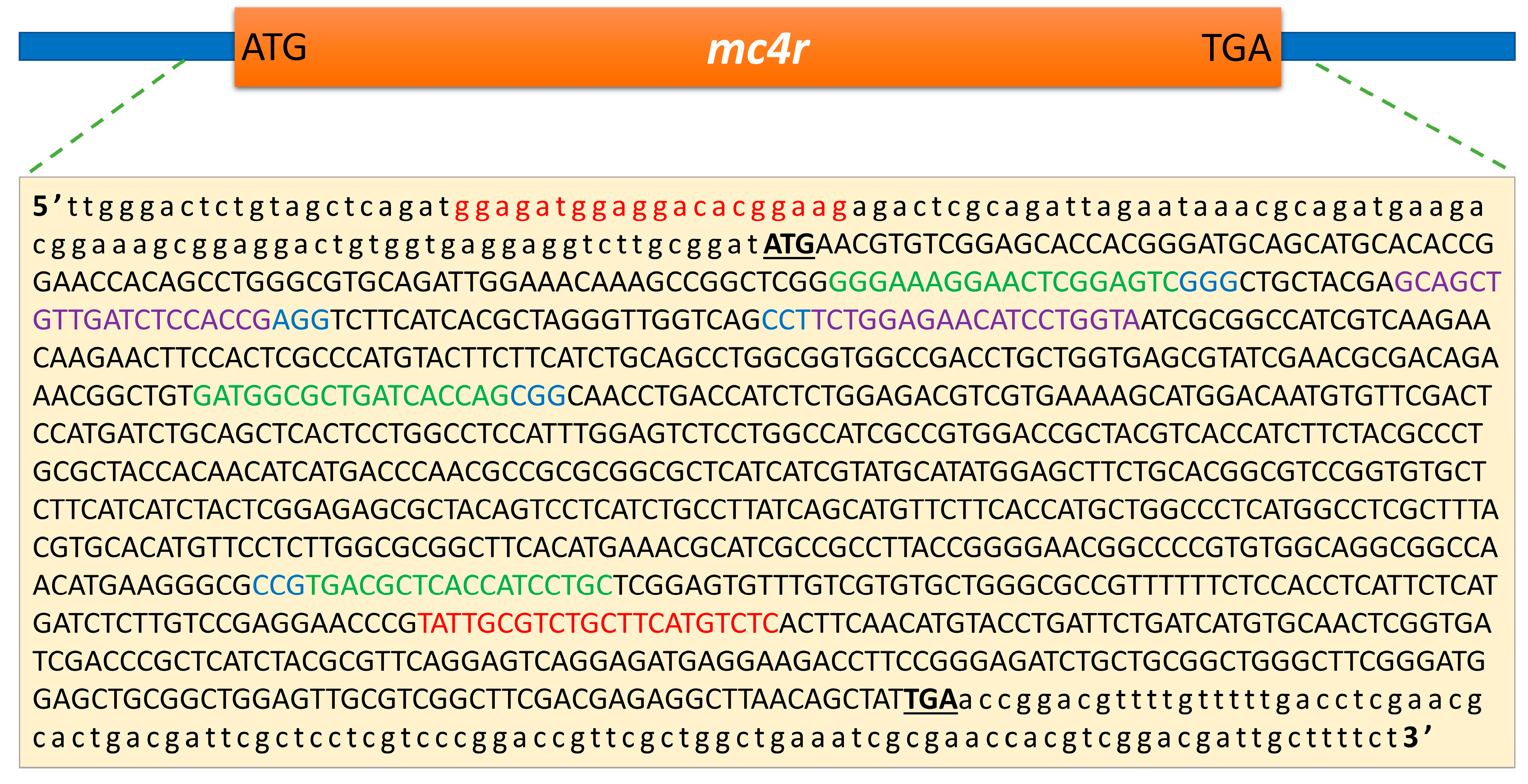
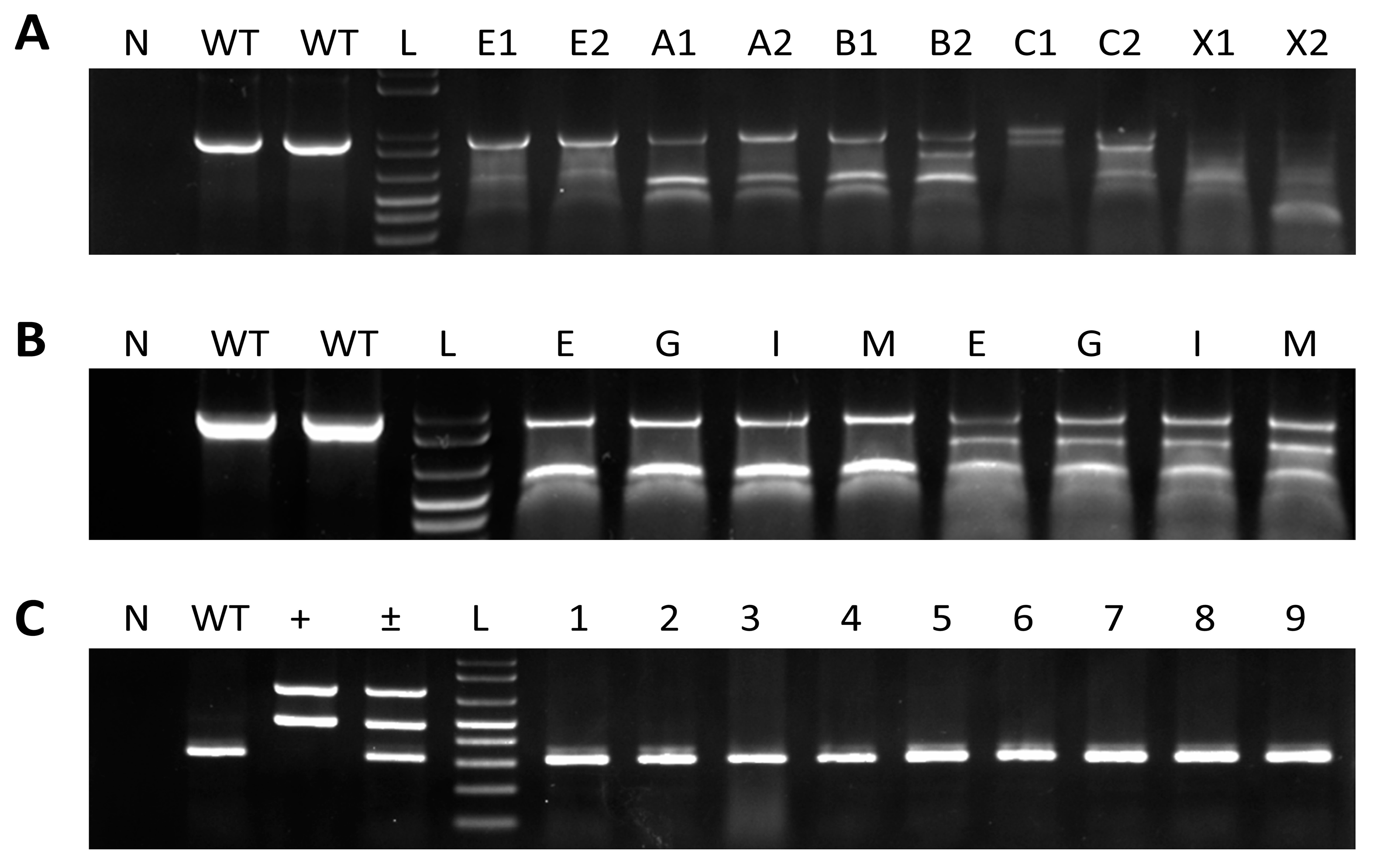

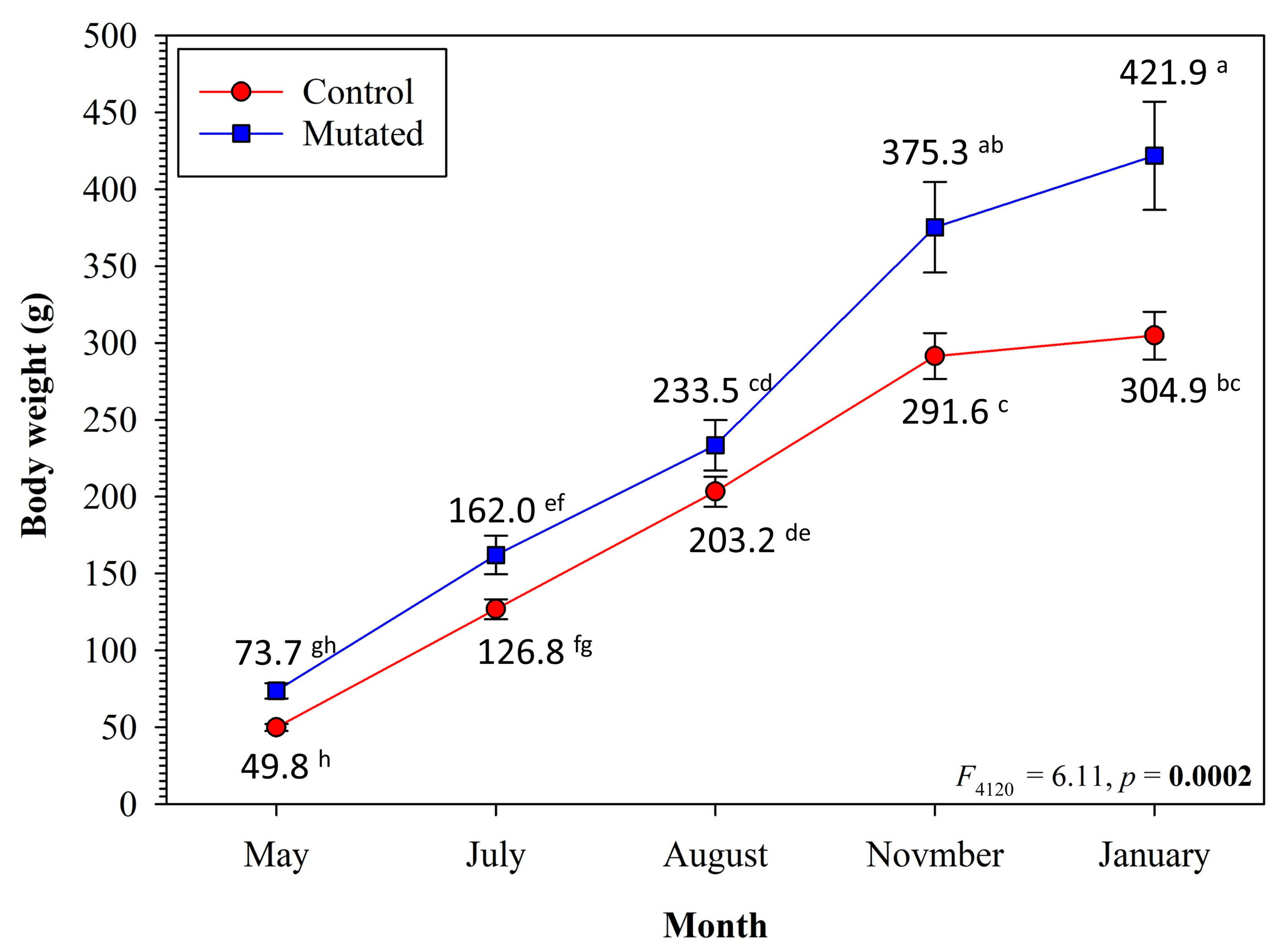
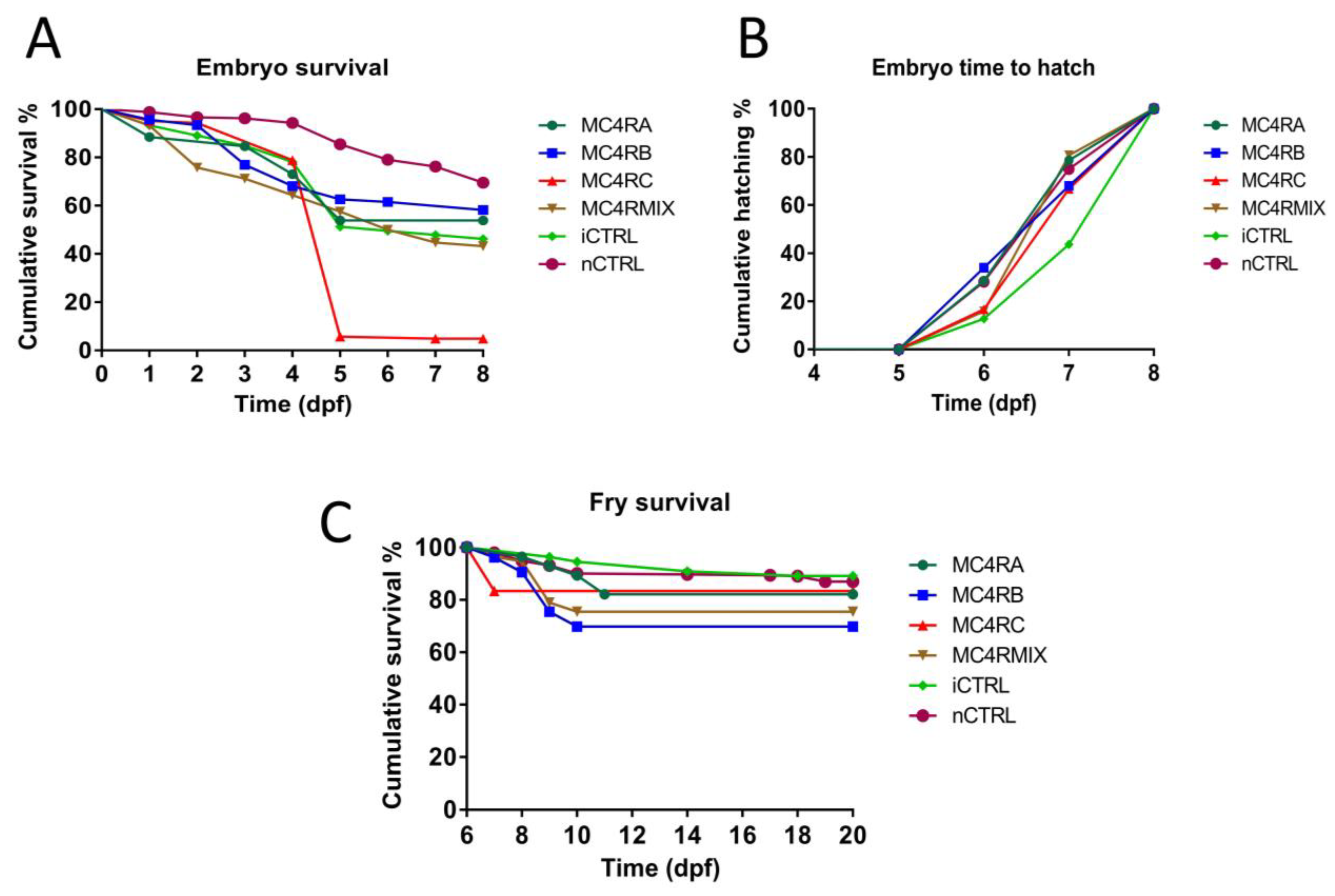
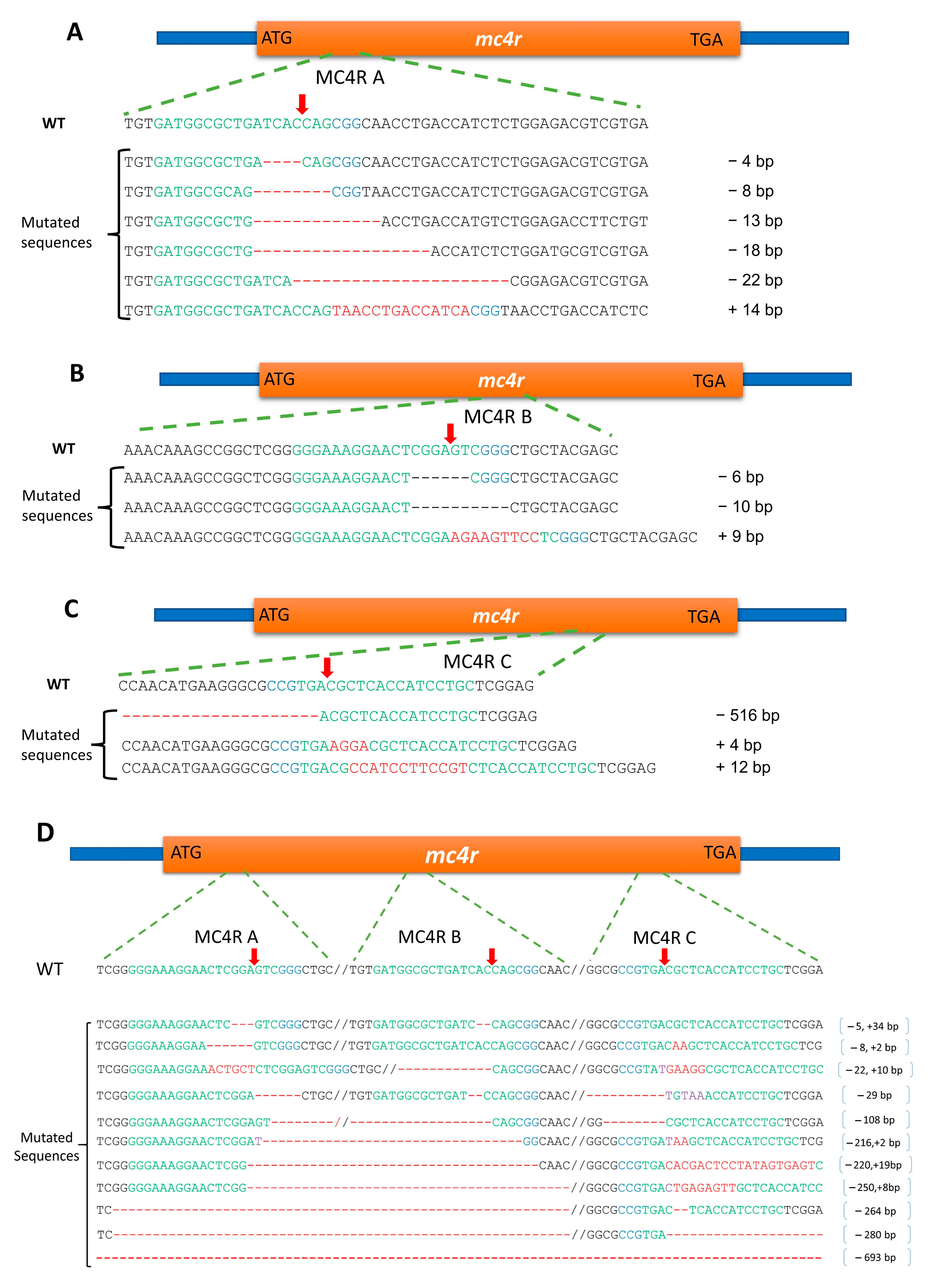
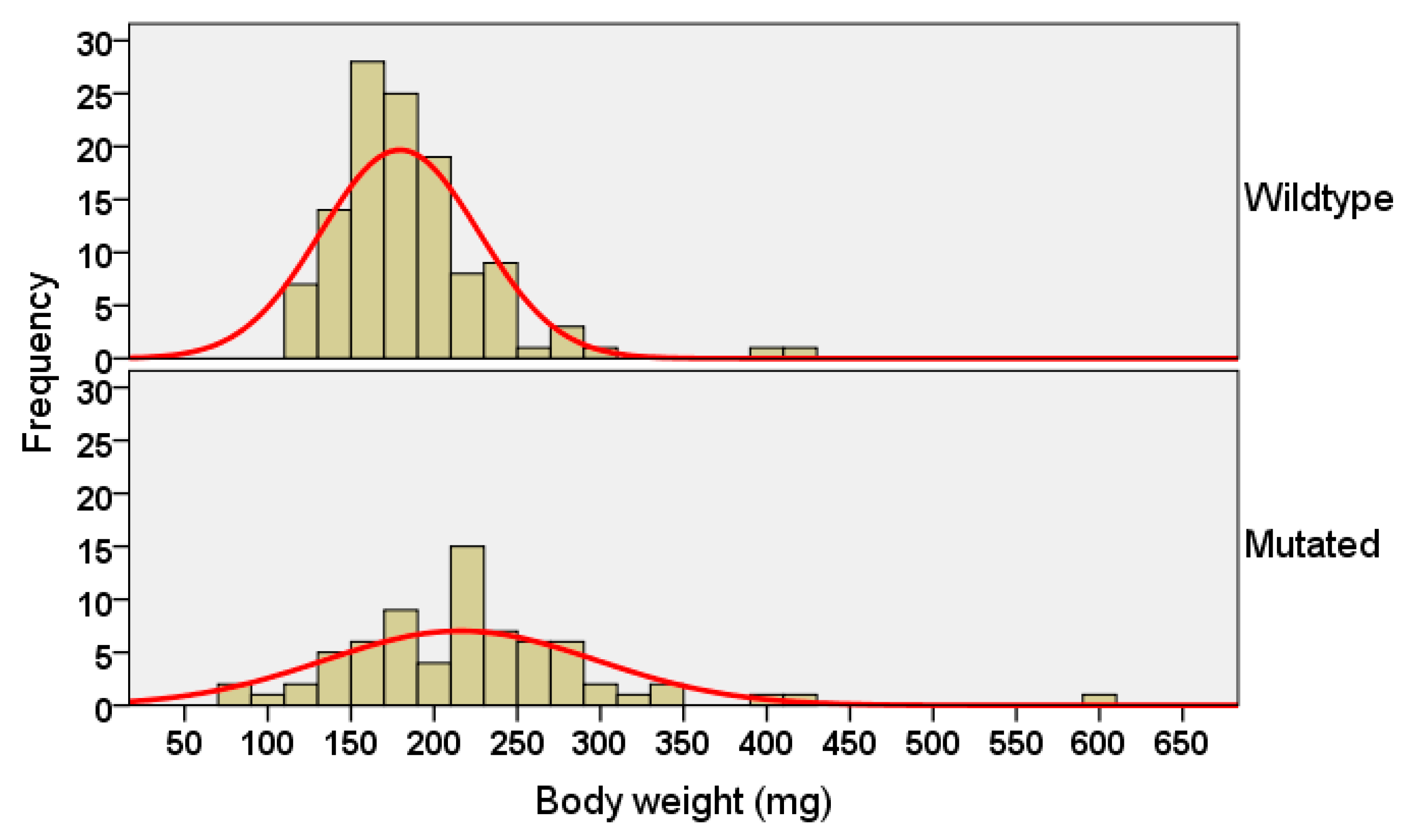
| Description | sgRNA Name | Oligo Sequence * (5′-3′) | Locus on Strand |
|---|---|---|---|
| Experiment I Electroporation | sgRNA I | GCAGCTGTTGATCTCCACCG | + |
| sgRNA II | TACCAGGATGTTCTCCAGA | − | |
|
Experiment II Microinjection | MC4R A | taatacgactcactataGGGATGGCGCTGATCACCAGgttttagagctagaa | + |
| MC4R B | taatacgactcactataGGGAAAGGAACTCGGAGTCgttttagagctagaa | + | |
| MC4R C | taatacgactcactataGGGCAGGATGGTGAGCGTCAgttttagagctagaa | − | |
| Universal primer | Aaaagcaccgactcggtgccactttttcaagttgataacggactagccttattttaacttgctatttctagctctaaaac |
| Primer Name | Primer Sequence (5′-3′) | Product Length (bp) | Description |
|---|---|---|---|
| MC4R-F | GGAGATGGAGGACACGGAAG | 932 | Amplification of mc4r gene and mutation detection |
| MC4R-R | GAGACATGAAGCAGACGCAATA | ||
| Cas9i-1F | CAGGCACAGCATCAAGAA | 715 | Detection of Cas9 plasmid integration |
| Cas9i-1R | GTTATCCAGGTCATCGTCAT | ||
| pU6d-1F | GAGGTAGTTGGCGTCATC | 484 | Detection of pU6dsgRNA plasmid integration |
| pU6d-1R | GCGAGTTCCATAGCGTTA | ||
| MSTNi-1F | ATTGTGAGGAGTGTGAGAC | 311 | Negative Control in integration detection |
| MSTNi-1R | AGAGACCAGGAGGAGAATT |
| Experiment | Group | Total Embryos | Dead Embryos | Embryo Mean Time to Death (Days ± SE) | Alive Embryos (Hatched) | Mean Time to Hatch (Days ± SE) | Fry Survival Rate (%) | Fry Mean Time to Death (Days ± SE) | Mutation Rate (%) | |||
|---|---|---|---|---|---|---|---|---|---|---|---|---|
| N | % | N | % | Embryo | Fry | |||||||
| I | Electroporated | 200 | 138 | 69.0 | - | 62 | 31.0 | - | 80.6 | - | - | 30.6 |
| Control | 200 | 113 | 56.5 | - | 87 | 43.5 | - | 90.8 | - | - | ||
| II | MC4RA | 52 | 24 | 46.2 | 5.9 ± 0.34 ab | 28 | 53.8 | 6.9 ± 0.14 b | 82.1 | 18.2 ± 0.74 ab | 87.5 | 78.6 |
| MC4RB | 91 | 38 | 41.8 | 6.2 ± 0.25 a | 53 | 58.2 | 7.0 ± 0.11 b | 69.8 | 16.6 ± 0.71 a | 92.1 | 90.6 | |
| MC4RC | 123 | 117 | 95.1 | 4.8 ± 0.12 | 6 | 4.9 | 7.2 ± 0.31 ab | 83.3 | 17.8 ± 1.98 ab | 87.2 | 66.7 | |
| MC4RMIX | 132 | 75 | 56.8 | 5.6 ± 0.23 b | 57 | 43.2 | 7.0 ± 0.08 b | 75.4 | 17.2 ± 0.64 a | 100.0 | 84.2 | |
| iCTRL | 119 | 64 | 53.2 | 5.9 ± 0.21 ab | 55 | 46.2 | 7.4 ± 0.10 a | 89.1 | 19.2 ± 0.35 b | - | - | |
| nCTRL | 420 | 128 | 30.5 | 7.3 ± 0.07 | 292 | 69.5 | 7.0 ± 0.04 b | 87.0 | 18.8 ± 0.20 b | - | - | |
| Group | Replicate | Initial Weight (g) | Final Weight (g) | Weight Gain (g) | Feed Given (g) | FCR * | |
|---|---|---|---|---|---|---|---|
| Replicate | Group | ||||||
| Mutated | 1 | 537.0 | 3575.5 | 3038.5 | 3199 | 1.05 | 1.18 |
| 2 | 642.0 | 3174.5 | 2532.5 | 3303 | 1.31 | ||
| Control | 1 | 412.0 | 2470.5 | 2058.5 | 3151 | 1.53 | 1.57 |
| 2 | 384.5 | 2408.0 | 2023.5 | 3240 | 1.60 | ||
Disclaimer/Publisher’s Note: The statements, opinions and data contained in all publications are solely those of the individual author(s) and contributor(s) and not of MDPI and/or the editor(s). MDPI and/or the editor(s) disclaim responsibility for any injury to people or property resulting from any ideas, methods, instructions or products referred to in the content. |
© 2023 by the authors. Licensee MDPI, Basel, Switzerland. This article is an open access article distributed under the terms and conditions of the Creative Commons Attribution (CC BY) license (https://creativecommons.org/licenses/by/4.0/).
Share and Cite
Khalil, K.; Elaswad, A.; Abdelrahman, H.; Michel, M.; Chen, W.; Liu, S.; Odin, R.; Ye, Z.; Drescher, D.; Vo, K.; et al. Editing the Melanocortin-4 Receptor Gene in Channel Catfish Using the CRISPR-Cas9 System. Fishes 2023, 8, 116. https://doi.org/10.3390/fishes8020116
Khalil K, Elaswad A, Abdelrahman H, Michel M, Chen W, Liu S, Odin R, Ye Z, Drescher D, Vo K, et al. Editing the Melanocortin-4 Receptor Gene in Channel Catfish Using the CRISPR-Cas9 System. Fishes. 2023; 8(2):116. https://doi.org/10.3390/fishes8020116
Chicago/Turabian StyleKhalil, Karim, Ahmed Elaswad, Hisham Abdelrahman, Maximillian Michel, Wenbiao Chen, Shikai Liu, Ramjie Odin, Zhi Ye, David Drescher, Khoi Vo, and et al. 2023. "Editing the Melanocortin-4 Receptor Gene in Channel Catfish Using the CRISPR-Cas9 System" Fishes 8, no. 2: 116. https://doi.org/10.3390/fishes8020116
APA StyleKhalil, K., Elaswad, A., Abdelrahman, H., Michel, M., Chen, W., Liu, S., Odin, R., Ye, Z., Drescher, D., Vo, K., Bugg, W. S., Qin, G., Yang, Y., Backenstose, N. J. C., Liu, Z., Cone, R. D., & Dunham, R. (2023). Editing the Melanocortin-4 Receptor Gene in Channel Catfish Using the CRISPR-Cas9 System. Fishes, 8(2), 116. https://doi.org/10.3390/fishes8020116









